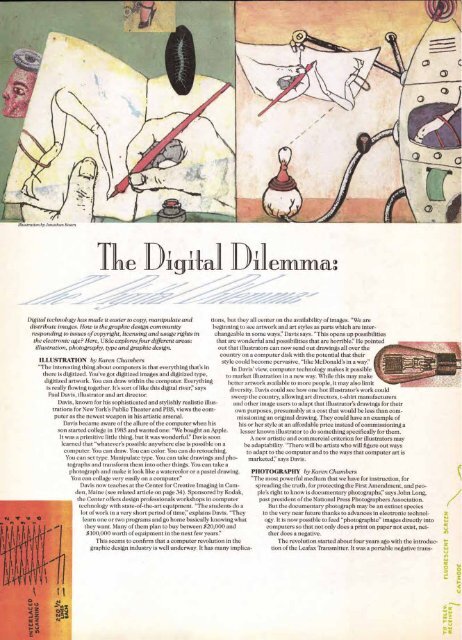Volume 19–4 (Low Res).pdf
Volume 19–4 (Low Res).pdf
Volume 19–4 (Low Res).pdf
Create successful ePaper yourself
Turn your PDF publications into a flip-book with our unique Google optimized e-Paper software.
The Digi .1 I )i emma:<br />
Digital technology has made it easier to copy, manipulate and tions, but they all center on the availability of images. "We are<br />
distribute images. How is the graphic design community beginning to see artwork and art styles as parts which are interresponding<br />
to issues of copyright, licensing and usage rights in changeable in some ways',' Davis says. "This opens up possibilities<br />
the electronic age? Here, U&lc exploresfour different areas: that are wonderful and possibilities that are horrible." He pointed<br />
illustration, photography, type and graphic design. out that illustrators can now send out drawings all over the<br />
country on a computer disk with the potential that their<br />
ILLUSTRATION by Karen Chambers style could become pervasive, "like McDonald's in a way?'<br />
"The interesting thing about computers is that everything that's in In Davis' view, computer technology makes it possible<br />
there is digitized. You've got digitized images and digitized type, to market illustration in a new way. While this may make<br />
digitized artwork. You can draw within the computer. Everything better artwork available to more people, it may also limit<br />
is really flowing together. It's sort of like this digital river;' says diversity. Davis could see how one hot illustrator's work could<br />
Paul Davis, illustrator and art director. sweep the country, allowing art directors, t-shirt manufacturers<br />
Davis, known for his sophisticated and stylishly realistic illus- and other image users to adapt that illustrator's drawings for their<br />
trations for New York's Public Theater and PBS, views the com- own purposes, presumably at a cost that would be less than computer<br />
as the newest weapon in his artistic arsenal. missioning an original drawing. They could have an example of<br />
Davis became aware of the allure of the computer when his his or her style at an affordable price instead of commissioning a<br />
son started college in 1985 and wanted one: "We bought an Apple. lesser known illustrator to do something specifically for them.<br />
It was a primitive little thing, but it was wonderful?' Davis soon A new artistic and commercial criterion for illustrators may<br />
learned that "whatever's possible anywhere else is possible on a be adaptability. "There will be artists who will figure out ways<br />
computer. You can draw. You can color. You can do retouching. to adapt to the computer and to the ways that computer art is<br />
You can set type. Manipulate type. You can take drawings and pho- marketed," says Davis.<br />
tographs and transform them into other things. You can take a<br />
photograph and make it look like a watercolor or a pastel drawing. PHOTOGRAPHY by Karen Chambers<br />
You can collage very easily on a computer?' "The most powerful medium that we have for instruction, for<br />
Davis now teaches at the Center for Creative Imaging in Cam- spreading the truth, for protecting the First Amendment, and peoden,<br />
Maine (see related article on page 34). Sponsored by Kodak, ple's right to know is documentary photographs;' says John Long,<br />
the Center offers design professionals workshops in computer past president of the National Press Photographers Association.<br />
technology with state-of-the-art equipment. "The students do a But the documentary photograph may be an extinct species<br />
N<br />
fl<br />
111 10<br />
lot of work in a very short period of time;' explains Davis. "They<br />
learn one or two programs and go home basically knowing what<br />
they want. Many of them plan to buy between $20,000 and<br />
in the very near future thanks to advances in electronic technology.<br />
It is now possible to feed "photographic" images directly into<br />
computers so that not only does a print on paper not exist, nei-<br />
$100,000 worth of equipment in the next few years?' ther does a negative.<br />
This seems to confirm that a computer revolution in the The revolution started about four years ago with the introduc-<br />
1 1 graphic design industry is well underway. It has many implica- tion of the Leafax Transmitter. It was a portable negative trans-<br />
I I<br />
CC Z<br />
L6.1 <<br />
kw;<br />
‘e
















